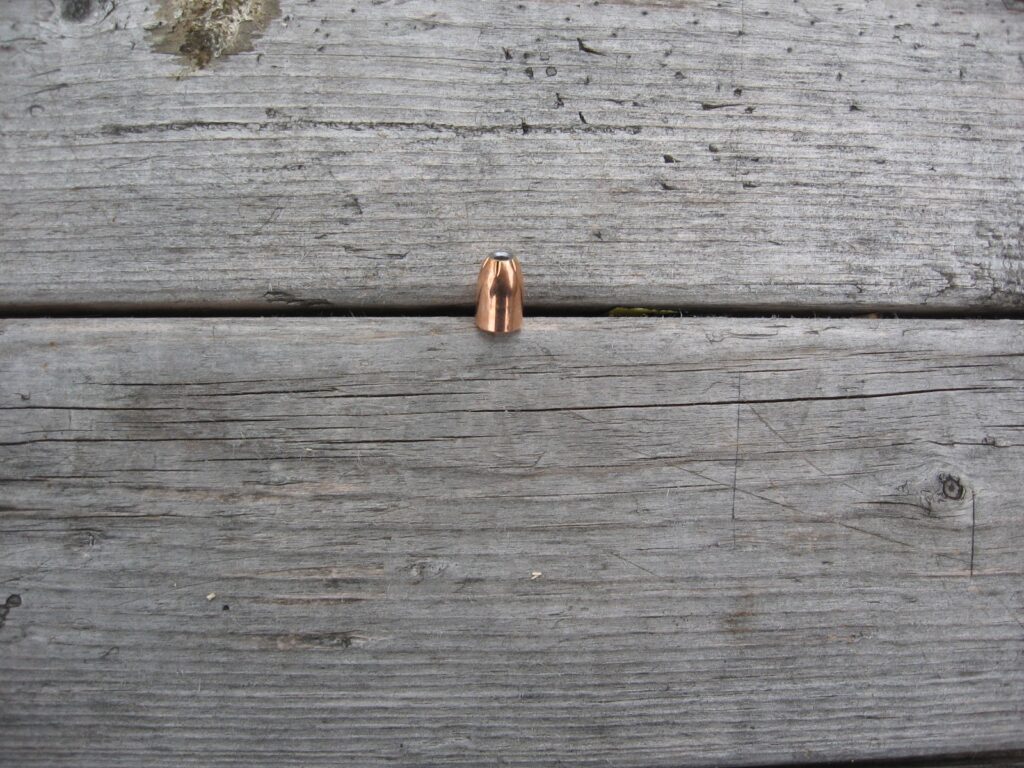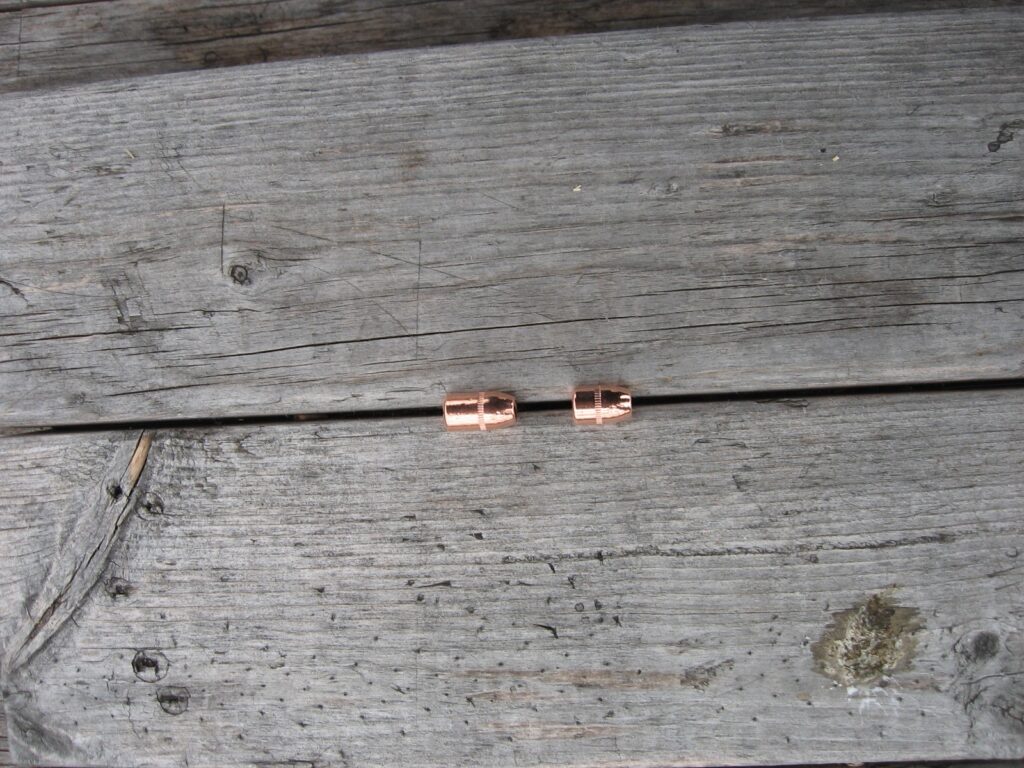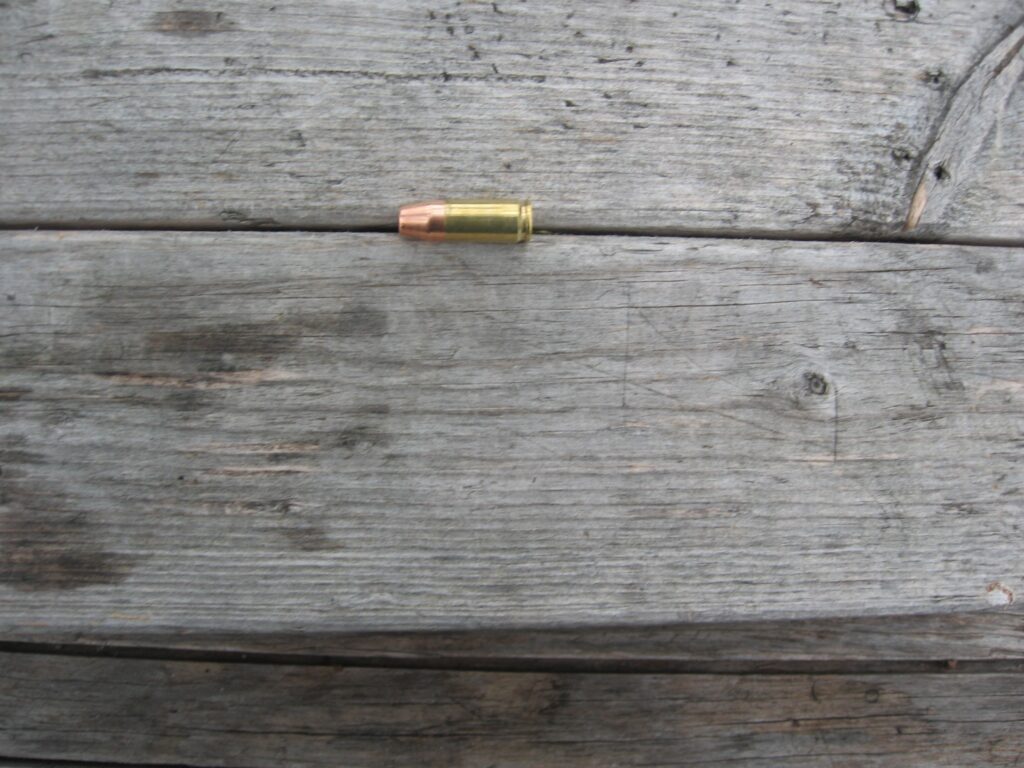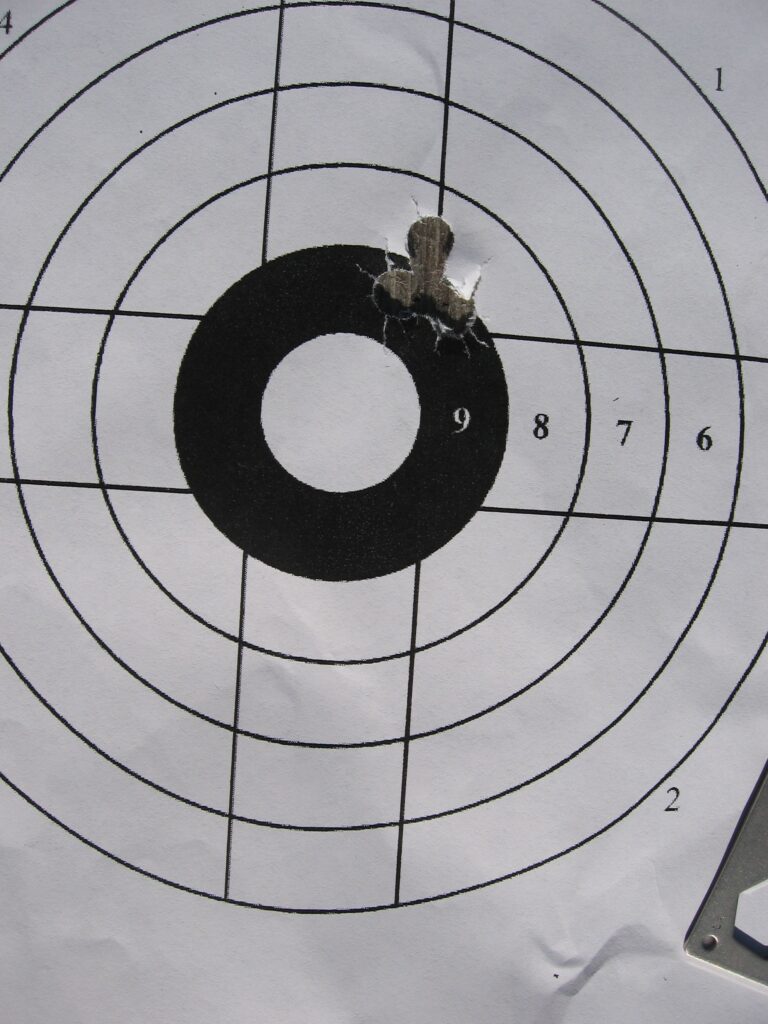RMR BULLET LOADS FOR FUN AND COMPETITION!
By: Kevin Newberry
Following my pattern of late, I’m beginning this article in advance of constructing the handloads or firing them. I’ll give some background and then begin making the handloads.
My first tests with the Rocky Mountain Reloading, RMR, 124 gr. In-House JHP were conducted 12/12/18. Jacob Wilcox of RMR supplied the bullets for testing which I’ve been doing periodically since then, using Accurate No 2 for loads just above 125 Power Factor for the competition minded. I’ve used some other Western Powders with this bullet, including a water jug test with Silhouette reaching 1181 FPS while the core and jacket did not separate. I decided not to push them any faster, but the designation of Multi-Purpose Round was assured in that test.

I should point out that the testing was done with the 4.47” Canik TP9sa that does not restrict OACL like many 9mm service pistols do these days. Just to refresh my memory, I did another chamber-length test just a few days ago and found the Max Possible OACL came in at 1.163”. The first test loads were 1.122”/28.5mm which is the length I’ve used mostly, and I’ve tested a few loads at 1.132”/28.75mm and 1.142”/29mm using No 2, Silhouette and True Blue. Since the original tests I have gradually increased the powder charge of No 2 to 4.2 grains. Right off the bat I found these loads to be very soft shooting, and in chronographing 10 rounds on several occasions, only one load has had a standard deviation above 5 FPS, and it came while using a WSP that gave a standard deviation of 8 FPS. All other loads since have been primed with a CCI 500, and on one occasion, SD dipped to 3 FPS.
If you have checked these bullets out on the RMR website you’ve no doubt seen the measurement comparisons to the Nosler .355” 124 gr. JHP. And it’s a good one to compare to as far as target grade accuracy. I have not used a great many of the Nosler 124 gr. JHPs because at 9 x 19mm velocity, even at +P velocity levels, I could not get them to expand. No such problem with the RMR 124 gr. JHP.
We do, however, need to discuss some handloading techniques. Both of the 124 gr. JHPs mentioned are very similar in profile. Their ogives being somewhat shorter than some other bullets you may have used. As a result, it is paramount that you find the correct OACL for these bullets, and from the pistol barrel they’ll be fired from. There is an article I wrote on that very subject right here on this forum that was posted November 13, 2015. https://blog.westernpowders.com/2015/11/important-steps-for-autoloading-cartridge-success/ In it you’ll find how to determine OACL for the 9mm jacketed bullet you intend to load, and cut down on the distance the bullet has to “jump” from the case into the rifling if you prefer. Another way to go is to follow the data provided by Sierra and Lyman. They both used the Sierra 125 gr. JHP and loaded them to a length of 1.075” which will work for the RMR 124 gr. JHP. Sierra has several loads that reach 1150 FPS and the RMR 124 gr. JHP is certainly capable of performing well at that velocity. As I mentioned, I pushed them as fast as 1181 FPS using Silhouette and what should still be a standard pressure load. I mention this because a number of ammo-makers have began attaching a +P designation for 124 gr. JHP loads at 1180 FPS, and sometimes even slower. There are a few of them that won’t chronograph any faster, while the manufacturers specs can show a velocity spec above 1200 FPS from their 4” test barrel. All the more reason to own and use a chronograph.
In the comparisons you can view at the RMR website you’ll see that the RMR 124 gr. JHP compares very favorably to the Nosler 124 gr. JHP. And while I couldn’t get the Nosler to expand much, I did find it to be a very accurate bullet. I think you’ll find the same with the RMR 124 gr. In-House JHP. I have made dimensional comparisons of my own, and with the last ones I loaded, the seating die was set while using a Winchester (WIN) 9mm case. They are still among the most consistent cases I measure within 1mm of the case-mouth, with thickness coming in at .011” on average, but be aware that even with cases of the same brand, there will be some thickness variation. What this relates to is OACL. With thicker cases mixed in, OACLs will be longer, thinner cases will yield a shorter OACL in comparison to the loads where OACL was determined with a case .011” thick near the case-mouth. Does that really matter? Some say no, and I’ve even seen a few reloaders state that OACL variations, a good bit greater than I’d allow, have very little effect on velocity and pressure. That may be a function of specific powders and their sensitivity, or lack thereof, to powder positioning. Many of you are aware that I make a good bit of defense ammo at Max Standard Pressure and +P in some cases. I can tell you that loads that vary by .010” will give different average velocities over your chrono. In fact, such a variation will have me adjusting the powder charge accordingly when I use Silhouette and Accurate No 7.
At the same time, I see handloaders jumping to a different powder when they might not be using the best techniques to ensure accuracy. Since this load is intended for Match use, I intend for mine to be Match Grade. In the past few years I’ve seen a good bit of difference in the thickness of 9mm cases. So I’ll state that I do my own form of sorting them. You won’t find many cases that are thinner than .010” near the case-mouth but there are some out there at .009”. I’ll mention that dial calipers like my Mitutoyo’s that are graduated in decimal/inches on the top of the beam, are graduated in millimeters on the bottom of the beam. So, I have a reference for 1mm and this does not have to be perfect, you’ll get a handle on that very quickly and .039 – .040” is close enough to 1mm. You will encounter brass from range pickups that were originally Target rounds that may have a cannelure on the case. It’s with these that I tend to find the thinner case walls. Loading them with cast/poly-coated/plated bullets of at least .356” dia. is a good way to use them. Most of the cases I load these days are easy to sort by brand, but I still run across something different on occasion. As you measure different brands it won’t take long to know which brands go in what bin. Military cases go into their own bin and may need to have the primer pocket uniformed after ensuring they weren’t Berdan primed. Many domestic cases are around the same thickness, but be aware that you’ll encounter at least two different types of Remington cases, and the newer ones are thicker than the older type. The text stamped into the case-rim is also different and the width of the rims appears to be different on the new style, but probably just a bit more bevel on the outside of the rim. A good many foreign brands are thicker and go into their own bin for loading at another time, and for a different purpose.
As mentioned, seating the 124 gr. RMR JHP into a WIN case for an OACL of 1.122”/28.5mm, in the case of my test pistol, measuring finished rounds throughout the process showed an OACL variation of +/- .002”. Very good in my opinion since not all cases are the same brand, but they are the ones closest to WIN in terms of case-wall thickness. Now I will mention that I load with a LEE Classic Turret Press, and have for a decade now. One reason for that is that it allows me to tell by feel when a case is out of the norm because your only dealing with one case and one die at a time. Enough so that I could actually sort accordingly. Another reason I continue to load with this press is because it has a top-dead-center feature like the Redding Boss I used previously. The purpose of that feature is to stop the Ram’s travel consistently at the same position every time while the turret and linkage completely flex. Back when I loaded everything on the Redding Boss, with a good uniform bullet, I could sometimes hold OACL variations to +/- .001”. I’m not gonna sweat .002”.
This is about more than nit-picking. It’s an indicator of how uniform the RMR 124 gr. JHP is. How much you decide to differ is entirely your call. But sometimes a powder may not have been used in such a way as to make a valid determination. And if someone tells you that standard deviation isn’t commensurate with accuracy, make sure to find out how accuracy was tested. If a Ransom Rest was used properly, that’s likely the best way to know. Anytime that human error is introduced, that must be considered as well. We know that bullets that differ in velocity will differ in point-of-impact as well. How much begins with the inherent mechanical accuracy of the firearm and all of those other “little things” combining into a greater overall effect.
I would recommend shooting groups from a rest to at least the same distance as the farthest target you’ll encounter in your particular sport. Most definitely if that sport is handgun hunting. For sport shooting it will show you the mechanical accuracy the load is capable of. How close the load will be to that when firing offhand is determined by the shooter. In my younger days I thought that 25 yards was the minimum mandatory distance for shooting groups with any handgun. I learned from wiser men that 50′ is plenty for fixed sight service pistols. Bullseye shooting and handgun hunting use more precise tools, so as Jack Nicholson said in The Departed, “act accordingly.”
Now for that recoil thing. I know I’m warped because I started handgunning about 40 years ago with magnum revolvers. My first big bore autoloader was a Colt Series 70 1911 Government model. I’d only owned a Tanfoglio Titan .380 before then. Shooting a 9mm autoloader for the first time was pretty sweet as far as recoil compared to ball ammo in .45 ACP, and that was before 124 and 147 gr. JHPs were available to handloaders. Due to bulk bullet pricing, I never loaded any FMJ, If I wanted to save money on bullets, I believed that commercially hard cast bullets were made for that and FMJ was just too close in price to same weight JHPs to matter. Having read what my handload manuals stated about using bullets at least .001” above the barrel’s groove diameter, I just never had problems with leading of the bore. Pistol or revolver.
So, how do we accurately determine recoil? I remember first reading about that in my Lyman 46th edition handloading manual with all of the known parameters included into an accurate calculation method for free recoil. Gun weight in pounds, bullet weight in pounds, powder charge weight in pounds, recoil velocity of the gun in FPS, muzzle velocity of the bullet in FPS and effective velocity of the powder charge. From there we get the answers. The formula does not change for rifle or handgun. But for handguns, as compared to say a hunting rifle and cartridge, just about everything gets scaled down accordingly. It’s just much easier to use the shorthand method we know as Power Factor. The problem I have is in determining any meaningful difference based on powder charge, at a given power factor at the same bullet weight. Instead of a hunting rifle cartridge that might take 40 – 70 grs of powder, or more, many handgun loads for 125 PF are 3 – 4 grs, give or take. I can get my head around effective velocity of the powder charge at 40 – 70 grs of powder, but 3 – 4 grs in a 9mm load? Are we not obsessing a bit?
My experience in working with the RMR 124 gr. JHP has been that at 4.2 grs of No 2, I don’t know how anyone could want a softer shooting 9 x 19mm load. It is very soft shooting, reliably cycles the slide and it’s very accurate with the stats revealing excellent uniformity. If we load for minor power factor with a bit of “safety cushion” for the different chronographs that can be used, or at say 130 PF, the velocity will need to be 1048 FPS for a 124 gr bullet and 884 FPS for a 147 to reach 130 PF. So is there really an advantage in using 147 gr. bullets for minor PF? I don’t personally pay much attention to trends, but one exists with many shooters believing that the recoil is lighter using a 147 gr bullet at 130 PF, even while there will be 1 gr. or less difference in powder charge. Is that enough to make a difference with a heavier bullet? Only you can determine that. But somehow I can’t help but recall a factor that is not likely being considered. That being dwell time in the bore. I think back to single-action cartridge revolvers from the 19th century. Did you ever wonder why their front sights are so tall? It is due to the different location the muzzle will be in between pulling the trigger and the bullet exiting the muzzle. Short and simple, a slower and heavier bullet will have a greater dwell time in the bore than a faster lighter bullet, and that equates to muzzle lift. So if a 147 is perceived to be softer shooting, is it enough to make up for the increase in muzzle rise or split times? Like I said earlier, I think the differences are minuscule, and I’m more interested in the most accurate load. But at 130 PF level, I believe any proof of an advantage will require fairly extensive testing by the shooter using a timer. And now we are seeing a number of 135-grain bullets that could make such an evaluation interesting as well. The good news here is that Accurate No 2 should be ideal for any of the three different weights.
I’ll also be testing Accurate No 2 for .38 Special loads and the ones I’ll be testing will use the RMR 125 and 158 gr. Plated Hollow-Points, or PHPs. 5.2 grs. of No 2 for the 125 gr. PHP and 4.0 grs. for the 158 gr PHP. These I expect to be very soft shooting, and I’m interested in both their accuracy and statistics. They will be tested with a 4.2” GP100, and truth is, it mainly gets fed with .357 Magnum for mostly double-action firing. The .38 Special loads should be great fun.

Since starting this article I’ve received a copy of the Western Powders Handloading Guide Edition 1 that Rob had meant to send previously. I had a copy in PDF from just before it was released when Rob asked me to evaluate it. I certainly like having a printed copy to take with me to the loading lab. I also believe that Rob did an exceptional job in writing what I believe are some of the best instructions available to all handloaders. It was also fortuitous that I read his preface to the .38 Special Data and found his comments regarding +P where he stated, “Ramshot True Blue and Accurate No 2 are clear standouts.” So before yesterday’s Super Bowl I made 200 more loads with True Blue where there is .38 Special +P data that used 125 and 158-grain Plated Hollow-Points. These loads are just under 20,000 PSI (the pressure limit for .38 +P), so be sure and work up from the start charge if you’ll be firing them from a .38 Special revolver. My .38 Special +P loads will only be fired from .357 Magnum revolvers.
I find it very convenient that from the nose to the cannelure of the RMR 125 & 158 grain .358” PHPs, the distance is near identical, so I did not adjust the seating stem after I finished the 125-grain loads and switched to the 158s. There is essentially no difference in the OACL of these two loads. I also found the RMR PHPs to be quite uniform in OACL for the loaded rounds at 1.445”. I used a standard CCI500 primer where I had been using a small pistol magnum primer with True Blue in .38 Special loads. I’ll be tickled pink if the lower velocities from the GP100s 4.2” Barrel are nearer to 130 PF. I have loaded these RMR PHPs in .357 Mag in a previous article.
Today is Tuesday, Feb 18th. We made it to the range yesterday for some testing. Due the pistol range getting crowded, I tried to shoot the tightest groups for each 10-round string I chrono’d at 12’ from the muzzle with the targets at 7 yards. The first two loads were charged with No 2 from other data sources. The charge for the 125 gr. PHP was 5.2 grs. and .1 gr. higher than the Western manual lists as the Max Charge at 5.1. As you might imagine, velocity from the 4.2” GP100 fell short of what was chrono’d from the Western 7.75” test barrel that shows 1074 FPS with a Rainier 125 gr. PHP. But given the fast burn rate of No 2 and the 941 FPS I chrono’d, I didn’t expect as much disparity in the velocities. I was lucky with the 158 gr. Charge I had decided on at 4.0 grs. of No 2 previously while it is also the Western .38+P Start Charge for the Berry’s 158 gr. FP. Western chronographed it at 790 FPS where with the same charge and the RMR 158 gr. PHP, I chrono’d 707 FPS. Extreme Spreads and Standard Deviation were a bit higher than I had hoped for, but accuracy was very good as you would expect at 7 yards.
I was a bit more optimistic when I got to the True Blue loads. I loaded up to the Max Charges for .38+P in both cases. My velocity with the RMR 125 gr. PHP was 1017 FPS where the Western 7.75” test barrel gave 1200 FPS using the Ranier 125 gr. PHP. ES and SD improved, but I think I’ll revert back to a magnum primer with True Blue for .38 Special loads. With the RMR 158 gr. PHP I chrono’d 792 FPS while the Western test barrel got 920 FPS using the Berry’s 158 gr. FP. In each load, the differences in OACL were slight enough to be negligible. The RMR 158 gr. PHP with 5.7 grs, of True Blue was the most accurate of these .38 Special +P loads. With the target I use, all of these loads are easily capable of putting 10 rounds in one hole in the white 10-ring. And with No 2, the Western Manual goes up to 4.4 grs. using the Berry’s 158 gr. Plated FP. I’ll show a target at the end of the article, because it will be a teaser for an upcoming article I’ll be writing on an experimental defense load.
Getting back to the 9mm loads; I’ve done a pretty good amount of tweaking with the RMR .355” 124 gr. In-House JHP and Accurate No 2 as well as other powders for different purposes including a very good defense load at 1181 FPS charged with Ramshot Silhouette as mentioned. I suspect that I’ve chrono’d about 8 different variations by now, if not more, with this bullet and Accurate No 2. In reviewing my chrono log I found that the best results occurred on 3/1/19 and the 4.2 gr. Charge was weighed on the RCBS RC130. The load I fired yesterday had its 4.3 gr. Charged weighed on the Frankford Arsenal DS-750, and as the model name implies, its weight limit is 750 grs. If there is a difference between the 2 scales, it can’t be more than .1 gr. That I’m fairly sure of. But the load fired back in March of last year also had a slightly longer OACL of 1.132” and approximately 28.75mm as I generally adjust my 9 x 19mm OACLs by quarter millimeters, or .010”. Velocity was 1028 FPS for a power factor 127.5. That’s cutting things very close, but Extreme Spread was only 12 FPS for 10 rounds with Standard Deviation at 3 FPS. That one I might try to squeak by with. Very accurate and very soft shooting with the benefit of using a powder that isn’t position-sensitive while its lower bulk density of 635 grams per liter (as far as spherical powders go) still gives decent case-fill.
Another comparison I wanted to make is recoil at 130 PF using 2 of the most common 9mm weights of 124 and 147 grs. This in connection to a conversation I was involved in while both True Blue and Accurate No 2 had been mentioned. The only 147 gr. bullets I had to work with were Winchester 147 gr. JHPs that were on the way, intended for defense loads. But with this article focused on RMR bullets, I checked to see if a 147 gr. JHP was available. All I can say on that score is not yet. And I’ve already admitted to having very limited experience with FMJ. But as we’re discussing competition loads at 130 PF, I thought, why not, and an email to Jacob Wilcox of Rocky Mountain Reloading solved that, except for the two choices available. With many 9mm service pistols having short chambers these days I selected the Truncated Cone version in hopes that I might be able to load them a bit longer. And they arrived as fast as the USPS could get them here.
With my first loads using the RMR 147 gr. TC FMJ, loading to 1.142”/29mm OACL and using a CCI500 primer with both True Blue and AA No 2, the goal was 884 FPS. Those first loads were fired on 2/28/20 to check velocity. I was actually a bit closer with the No 2 load, but as I’ve mentioned before about True Blue’s uniformity, I determined the charge would need to go up by .2 grs.

The pic above shows one of the cartridges I fired this past Thursday 3/12/20 with the temperature at 82 degrees. The 4.6 gr. Charge of True Blue produced exactly 884 FPS with the charge of No 2 being exactly one grain less at 3.6 grs. giving 881 FPS with both being 10 shot strings with the center of the chronograph 12’ from the muzzle and the target stand at 7 yards. Any perceived difference in recoil was just too slight to discern. But as I said I would do in the conversation I mentioned, I tried comparing them in offhand shooting including a few magazines of both loads alternating in sequence. Maybe you’ll have more luck than I did, but I could not tell any discernible difference. And the 124 gr. RMR JHP loads at 1028 FPS? I think I’d need to fire a couple of hundred rounds to see if I could tell any difference. So in conclusion, so far as I’m concerned, these are all great candidates for competition shooting to include the RMR 158 gr. PHP charged with True Blue in .38 Special. I have to say that I very much enjoyed using the RMR 147 gr. TC FMJs. But there was one last question to answer, that being if it would fit in a short chamber. Between my shooting partner and me, I suspect that the 9mm pistol with the shortest chamber would be his HK VP9. We removed its barrel for the famous “Plunk” test, and it certainly plunked. Tilting the muzzle upward, the cartridge did not fall out. There might have been a couple of different reasons for that. One, the bullet was just barely touching the lands, and two, the pistol has a “stepped chamber” and maybe a bit tighter on the case-neck. Shortening the load to say 1.135” should solve that, or load shorter if you prefer.
Now we’re at the end and I mentioned that there would be a teaser, and I used the targets we use mostly, while one single round was fired. That leaves you from now until that article to decide how that was accomplished. In the meantime, I have a bit more work to do to get the final result I’m looking for.
And as always, God Bless, be safe, and good shooting to you all!

